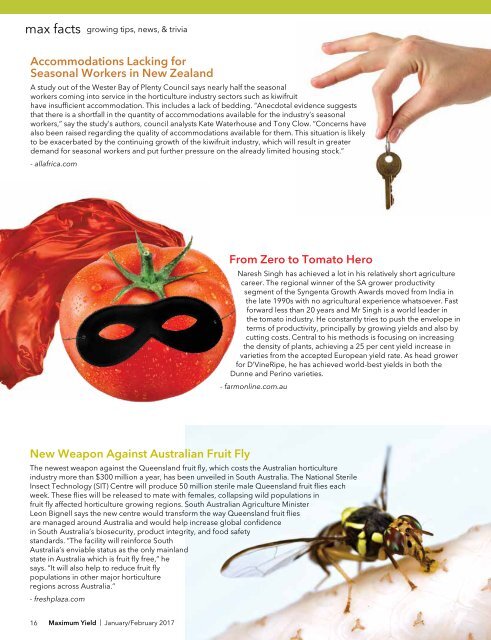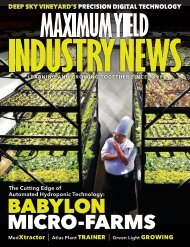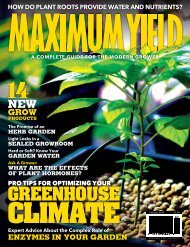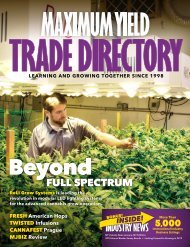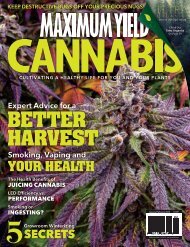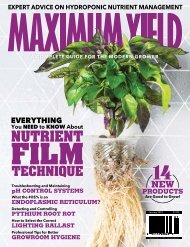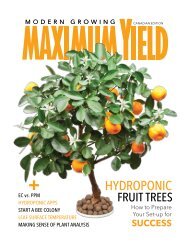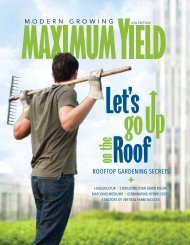Maximum Yield Modern Growing | AUS/NZ Edition | January/February 2017
The world of indoor growing is expanding at an incredible rate. No longer the alternative to traditional agriculture, hydroponics is being recognised as beneficial for many important reasons. Hydroponics yields require up to 50 per cent less land to grow the same amount of produce, and as the world’s arable lands are diminished from overfarming and climate change, hydroponics takes the pressure off the environment by leaving more land available for wildlife reserves, biospheres, and other protected areas. Drought-ridden areas like California will appreciate the fact hydroponics uses only 10 per cent of the water needed for growing in soil, and far less chemicals and fertilisers-as much as 60 per cent less- are required. By most reports, growing and transporting food around the globe accounts for as much as 30 per cent of all greenhouse gas emissions. With hydroponics, we can grow almost anything right where we live, reducing the need for carbon emissions. This is especially important for people who live in the Far North. More and more, programs are being created to provide fresh produce for those who live in northern communities, reducing the need to ship relatively small amounts of food while providing food security with fresh, inexpensive fruits and vegetables. It is with these shifts in mind that we’ve made some editorial changes in Maximum Yield. As you may have noticed, on our cover we’ve changed ‘indoor gardening’ to ‘modern growing’. As the industry evolves, so are we. Our content will include a wider look at the advancements in the growing world, both indoors and out. As we flip the calendar from 2016 to 2017, we are taking a new perspective on the world of modern growing, and we look forward to bringing these stories to you. We also wish you and your loved ones the very best for 2017. In the meantime, we hope you have as much fun reading this issue as we did putting it together. As always, thanks for reading Maximum Yield and if you have any questions feel free to contact us at editor@maximumyield.com.
The world of indoor growing is expanding at an incredible rate. No longer the alternative to traditional agriculture, hydroponics is being recognised as beneficial for many important reasons. Hydroponics yields require up to 50 per cent less land to grow the same amount of produce, and as the world’s arable lands are diminished from overfarming and climate change, hydroponics takes the pressure off the environment by leaving more land available for wildlife reserves, biospheres, and other protected areas. Drought-ridden areas like California will appreciate the fact hydroponics uses only 10 per cent of the water needed for growing in soil, and far less chemicals and fertilisers-as much as 60 per cent less- are required. By most reports, growing and transporting food around the globe accounts for as much as 30 per cent of all greenhouse gas emissions. With hydroponics, we can grow almost anything right where we live, reducing the need for carbon emissions. This is especially important for people who live in the Far North. More and more, programs are being created to provide fresh produce for those who live in northern communities, reducing the need to ship relatively small amounts of food while providing food security with fresh, inexpensive fruits and vegetables. It is with these shifts in mind that we’ve made some editorial changes in Maximum Yield. As you may have noticed, on our cover we’ve changed ‘indoor gardening’ to ‘modern growing’. As the industry evolves, so are we. Our content will include a wider look at the advancements in the growing world, both indoors and out. As we flip the calendar from 2016 to 2017, we are taking a new perspective on the world of modern growing, and we look forward to bringing these stories to you. We also wish you and your loved ones the very best for 2017. In the meantime, we hope you have as much fun reading this issue as we did putting it together. As always, thanks for reading Maximum Yield and if you have any questions feel free to contact us at editor@maximumyield.com.
Create successful ePaper yourself
Turn your PDF publications into a flip-book with our unique Google optimized e-Paper software.
max facts growing tips, news, & trivia<br />
Accommodations Lacking for<br />
Seasonal Workers in New Zealand<br />
A study out of the Wester Bay of Plenty Council says nearly half the seasonal<br />
workers coming into service in the horticulture industry sectors such as kiwifruit<br />
have insufficient accommodation. This includes a lack of bedding. “Anecdotal evidence suggests<br />
that there is a shortfall in the quantity of accommodations available for the industry’s seasonal<br />
workers,” say the study’s authors, council analysts Kate Waterhouse and Tony Clow. “Concerns have<br />
also been raised regarding the quality of accommodations available for them. This situation is likely<br />
to be exacerbated by the continuing growth of the kiwifruit industry, which will result in greater<br />
demand for seasonal workers and put further pressure on the already limited housing stock.”<br />
- allafrica.com<br />
From Zero to Tomato Hero<br />
Naresh Singh has achieved a lot in his relatively short agriculture<br />
career. The regional winner of the SA grower productivity<br />
segment of the Syngenta Growth Awards moved from India in<br />
the late 1990s with no agricultural experience whatsoever. Fast<br />
forward less than 20 years and Mr Singh is a world leader in<br />
the tomato industry. He constantly tries to push the envelope in<br />
terms of productivity, principally by growing yields and also by<br />
cutting costs. Central to his methods is focusing on increasing<br />
the density of plants, achieving a 25 per cent yield increase in<br />
varieties from the accepted European yield rate. As head grower<br />
for D’VineRipe, he has achieved world-best yields in both the<br />
Dunne and Perino varieties.<br />
- farmonline.com.au<br />
New Weapon Against Australian Fruit Fly<br />
The newest weapon against the Queensland fruit fly, which costs the Australian horticulture<br />
industry more than $300 million a year, has been unveiled in South Australia. The National Sterile<br />
Insect Technology (SIT) Centre will produce 50 million sterile male Queensland fruit flies each<br />
week. These flies will be released to mate with females, collapsing wild populations in<br />
fruit fly affected horticulture growing regions. South Australian Agriculture Minister<br />
Leon Bignell says the new centre would transform the way Queensland fruit flies<br />
are managed around Australia and would help increase global confidence<br />
in South Australia’s biosecurity, product integrity, and food safety<br />
standards. “The facility will reinforce South<br />
Australia’s enviable status as the only mainland<br />
state in Australia which is fruit fly free,” he<br />
says. “It will also help to reduce fruit fly<br />
populations in other major horticulture<br />
regions across Australia.”<br />
- freshplaza.com<br />
16 <strong>Maximum</strong> <strong>Yield</strong> | <strong>January</strong>/<strong>February</strong> <strong>2017</strong>


